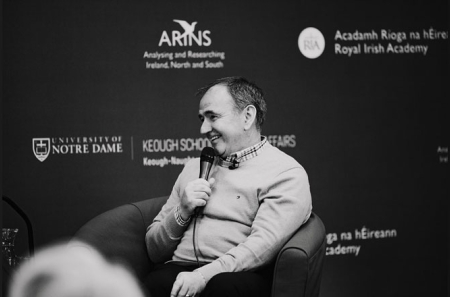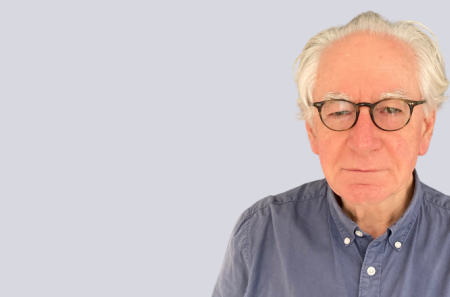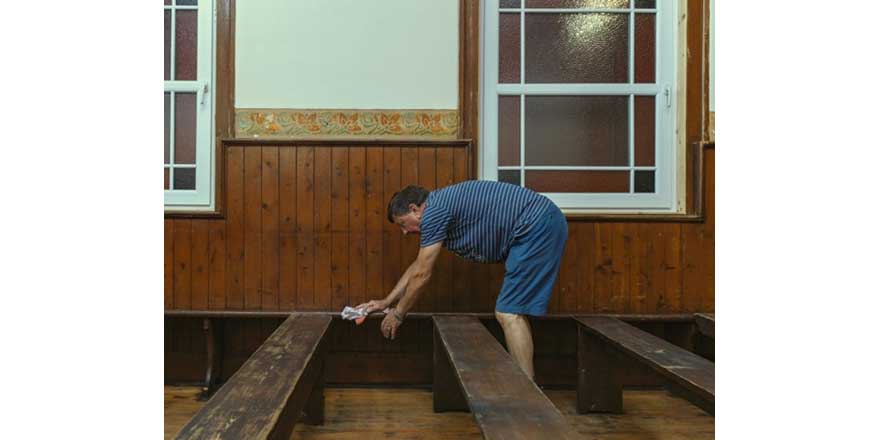
Orange Halls along the border: Brian Newman’s 'Association' and the quandary of unionism
12 March 2024By Colin Graham
A man sits alone at a communal meeting table, playing the flute (Figure 1). The walls are bare and sparse. He looks as if he is remembering more than just the tune he’s playing. This is one of a series of similar images from Brian Newman’s new photobook entitled Association. Newman’s project began when, working as a news cameraman, he visited the site of Inverhall Orange Hall in 2011 on the day it had been burnt down in an arson attack. That day he photographed the remnants of the hall with two women looking in through the windows. There was clearly something about the women’s position outside the building, the event of the fire, and the scorched darkness visible through the windows of the building that piqued Newman’s interest, because he then dedicated himself to making a carefully crafted photographic study of Orange Halls along the border region.
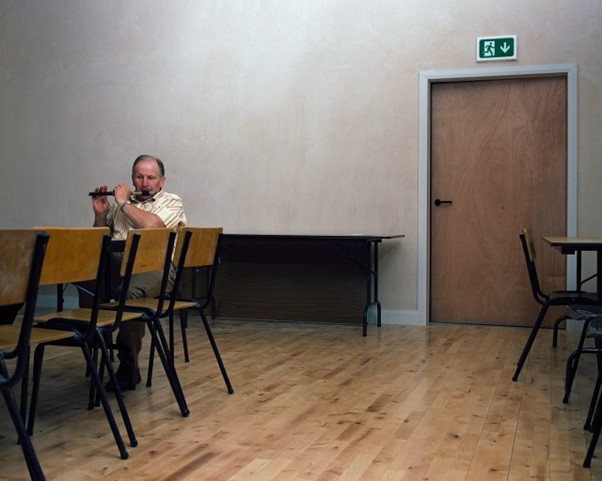
Figure 1
The usefulness of the Orange Order’s role in helping us understand contemporary loyalism and unionism was highlighted recently in the fallout within unionism over the DUP’s decision to return to the Assembly and Executive. Rev. Mervyn Gibson, the Order’s Grand Secretary, came out early to back the deal that the DUP had come to with the British Government via the ‘Safeguarding the Union’ Command Paper, describing it as ‘a win for unionist determination and unity’. At the same time, Rev. Gibson tried to anticipate the dissent that he knew would follow the deal, arguing that unionism should ‘not turn a significant victory into a defeat’.(1) As it happened, the first organised event protesting against the deal occurred in an Orange Hall in the village of Moygashel, County Tyrone. And three days after reporting on Gibson’s support for the deal, Suzanne Breen of the Belfast Telegraph was quoting an anonymous member of the Order, well versed in the rhetoric of the deal’s opponents, who was warning that Gibson’s support for the deal was premature.(2) The Orange Order’s official newsletter, Orange Standard, meanwhile, was non-committal, with Grand Master Most Wor. Bro. Edward Stevenson acknowledging receipt of the Command Paper and saying it needed ‘careful consideration’.(3)
This division in the Orange Order situates itself precisely at the fundamental dilemma, between pragmatism and dogmatism, faced by unionism now. That, in order to set up acceptance of the deal, DUP leader Jeffrey Donaldson felt the need to state a commitment to the principle of devolved government (in the Northern Ireland [Executive Formation] Bill debate on 24 January 2024: ‘To be absolutely clear, the Democratic Unionist Party supports devolution’ (4)), shows the post-Brexit state of disarray in which unionism has found itself. In the debate in the Commons on ‘Safeguarding the Union’, Donaldson tried to regather unionism to, as former secretary of state Julian Smith put it, make ‘Northern Ireland a success’ (5); a sentiment—that effective devolved government is the way to secure support for the Union—that is a long way from the rhetoric of those associated with the anti-Protocol and anti-Windsor Framework factions of unionism with whom Donaldson had shared a platform in April 2022.
The predicament that unionism finds itself in post-Brexit is an intensified version of the unsettled sense of its future that it has had since at least the Anglo-Irish Agreement (1985)—looking to restate and reinforce Northern Ireland’s Britishness but unsure if the ‘Britain’ that unionism attaches itself to recognises unionism’s very own version of Britishness. Unionism and loyalism will continue to be pulled between these forces: the defiance of the anti-Protocol faction, led by TUV MLA Jim Allister and loyalist blogger Jamie Bryson, on the one hand and, on the other, the attempt, currently represented by Donaldson’s acceptance of the Safeguarding the Union deal, to ‘make Northern Ireland work’. In his passionately sympathetic account of interviews with members of the Independent Orange Order, James Wilson notes that ‘Independent Orangeism’s Northern Ireland is an idealised 1950s historical theme park’ (6) and certainly this is one possible outcome of the strain caused by these forces and choices—a kind of impotent benign nostalgia that hopes to see a supposedly amenable past erupting into and replacing the unsettled present. The Orange Order’s role in unionism’s current dynamic is probably not crucial to the new Executive’s political success (though, as McAuley et al. point out, ‘Orangeism remains bigger than the formal membership of the Orange Order’ (7) and is thus influential in unionism in a way that is disproportionate to the falling numbers of its membership). However, as unionism reorients itself after the DUP’s return to Stormont, the Orange Order will remain a kind of weather station for unionism, where the temperature can be taken and from which future atmospherics can be projected.
The Orange Order member who sits at the table in Brain Newman’s photograph, playing his flute, as with the rest of Newman’s work in Association, is the epitome of the state of confusion and uncertainty (and potential entropy) that unionism faces. In the inscrutability of this man’s gaze (into the future or the past?) is the quandary of unionism and the Orange Order. This is mirrored by the photographer’s difficulty in seeing inside the heritage, thinking and everyday existence of Orangeism—a difficulty that is deliberately integrated into the aesthetics of the images in Association.
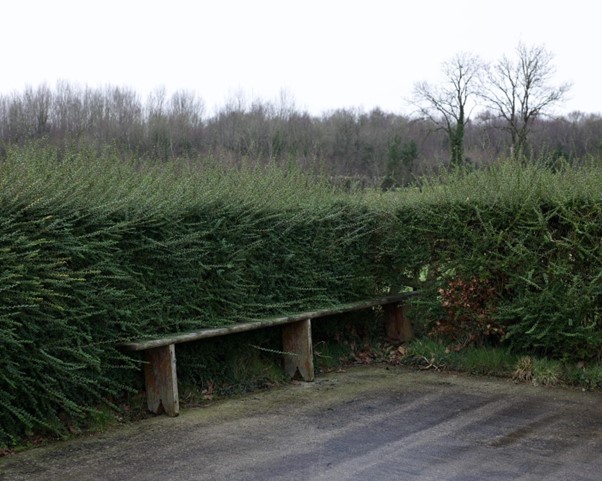
Figure 2
It was perhaps this sense that the Orange Order is both out-of-time and significant that led Brian Newman to begin a photographic project about the Order, and perhaps this is why his final manifestation of that project is, in effect, a journey inside its fabric. His book begins with the exteriors of Orange Halls and enters those spaces, gradually and tentatively, in the company of those who care for the buildings.
The prefatory image in the book is of a bench and a hedge (Figure 2) and is a distillation of what is to follow. The bench in the image is slightly decayed; the hedge, in the form of a barrier and boundary marker, is unkempt; the tarmac on the ground is mossed. This photograph, then, sets the tone for Association—the Orange Order, as seen here, rests on a desire for certainty, for solid and knowable patterns, but is currently, in an understated way, overwhelmed and unable to keep its physical (and, perhaps, ideological) structures in a state of ‘order’.
Newman’s photographic approach to the Orange Order is intimate and empathetically analytical. He does not intrude or interpret. He offers up a close (but not close-up) portrait of an institution. His photographic style sits between art photography and documentary photography in a way that has a clear lineage in recent decades in Northern Ireland. (8) It is a mode of photography that allows for a long, slow look at things, and in which the physical textures of objects, landscapes and materials become meaningful. Most obviously, this is undramatic photography. We might think of the Orange Order primarily through its parades—public, colourful, performative acts of celebration and heritage, or triumphalism and intimidation, depending on one’s viewpoint. In Newman’s work the colour and bombast have been drained, so that the images are dominated by the grey and the drab—the concrete of the car park, the rendering on the wall, the industrial steel of the shipping container. And the lines where these dullnesses meet draw the eye to the banal—a perhaps symbolic closed door and a barrier (Figure 3).
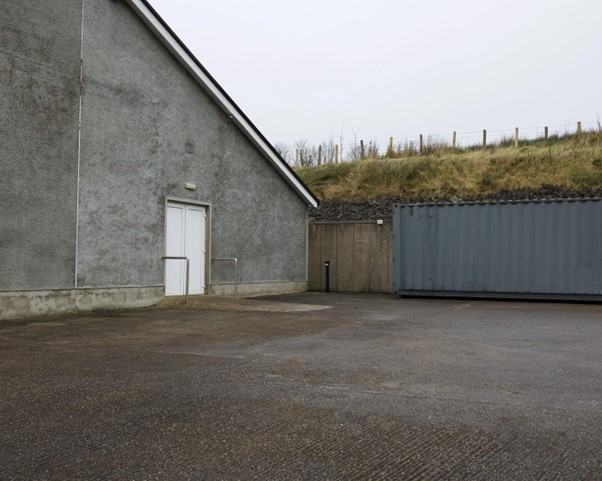
Figure 3
The exteriors of Orange Halls, as seen by Newman, are austere and often securitised with lights and alarms. For all its public swagger on the Twelfth, the Orange Order in the border counties has a long (and recent) history of feeling under threat from its surroundings. (The final image in Association is of a member of the Order locking the gates outside Fawney Orange Hall, near Lisnaskea in Co Fermanagh—the Hall there has been burned down twice in its history and was most recently attacked in 2013, when it was broken into and vandalised. (9)) Therefore an image of a member of the Order opening a door for, as it were, Newman’s camera to enter, has a particular resonance. (Figure 4) It is a reminder of the need for security, and of the challenges that the Order presents to others and feels are directed towards it. Again Newman’s careful photography underlines this fraught caution—the viewpoint in the image means that the actual unlocking of the door is hidden.
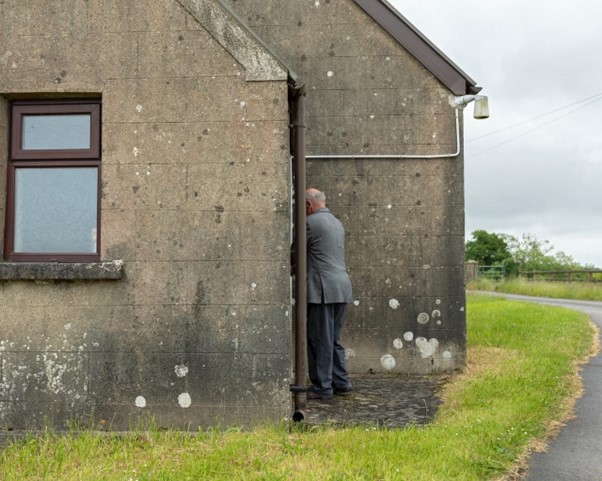
Figure 4
Once he is inside the Orange Halls, this sense of discretion and guardedness is constantly repeated in the gestures that Newman’s portraiture chooses to show. The men (they are all men) who let him into these institutions are seen primarily as caretakers; opening curtains, tidying things away, making preparations (Figure 5). In this context a photograph as apparently ordinary as that of two institutionally comfortable chairs with a radiator behind them and a tablecloth in front of them takes on a resonance because we look at it for longer than usual and try to place it in the sequence of images. The expectations of this specific setting are that there will be a communal gathering and that business will be done. And yet the interiors of the Halls in Association are continually and melancholically empty, always being prepared for use by their caretakers, but never actually in use.
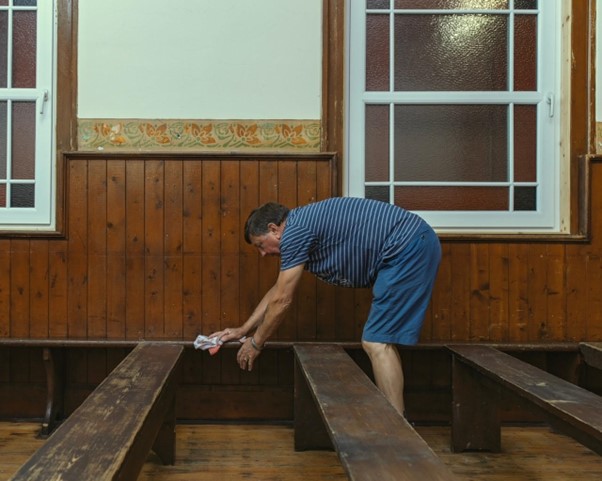
Figure 5
The Orange Halls in Association are clearly places where ‘community’ is meant to happen. The series of images is not devoid of politics—Queen Elizabeth II’s portrait appears in one image, as does an Orange banner in just one photograph. But so does a Cornetto ice-cream fridge. And the interiors of these Orange Halls are places of performance—there are signs of musical performance (including a cowboy hat), singing, playing the flute, preaching, and there are carefully tended stages. But this is mostly a very different type of performance—intimate, social—than that of the parades that we normally associate with the Orange Order.
Perhaps the most significant thing about Newman’s work here is that there are no face-on portraits. All the men are seen from the back or from the side. We see them accidentally, as if they are busy or shy. The effect is to make this inside view of the Orange Order remain partial and to reaffirm that what it represents is not fully seen here. And that leaves us with a question about how much we know about the lives, motivations and futures of the people we see in these images, and the ideas and affiliations that they represent. As the series of photographs leaves the Orange Halls towards the end of the book and returns to the outdoors, there are images of the countryside surrounding the Halls in the border region. But these are not sweeping landscape views. They are stifled and enclosed and often, as in the image of the telegraph pole, visually split down the centre. (Figure 6)
The banality of these photographs is their point, since what lies inside the Orange Halls is very ordinary. In that, Association is a chance to pause and think about the politics that surfaces through the images; the religiosity, which is apparent occasionally; the loyalty, of those who attend these Halls, to what the British royal family means to them; the relationship of those who move in and then out of Hall to the border landscape outside.
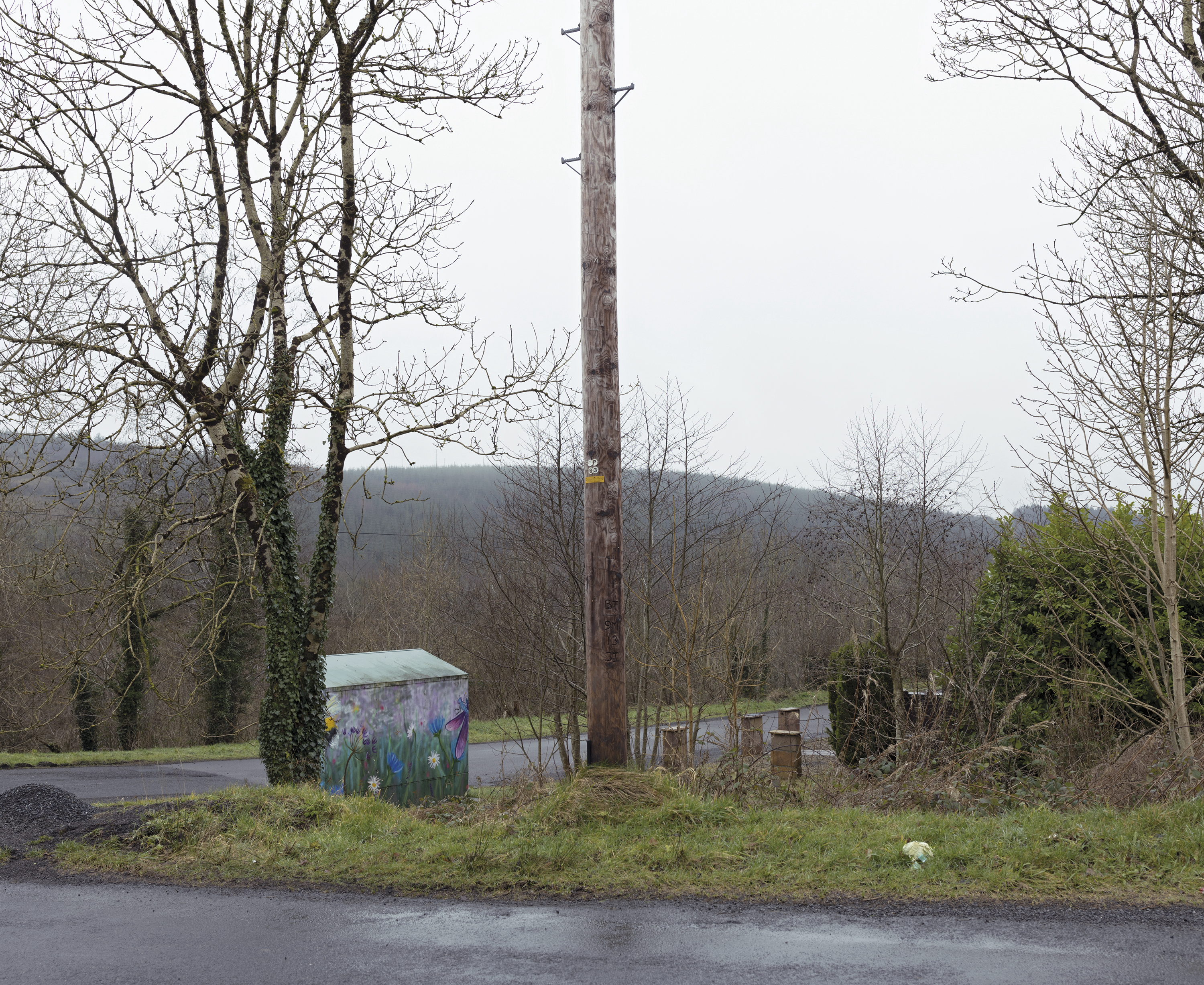
Figure 6
The real or potential isolation of loyalism, which is empathetically imagined in Newman’s work, has perhaps no better recent political expression than during Jamie Bryson’s oral evidence to the House of Commons Northern Ireland Affairs Committee in October 2023. After some tetchy exchanges with the Chair and two other Conservative members of the committee (including former lord high chancellor Sir Robert Buckland) about Bryson’s bona fides in speaking for loyalism and his legal views on the Protocol, Carla Lockhart, DUP MP for Upper Bann, began her questions to Mr Bryson with a complaint:
Sadly, for any loyalist watching these proceedings, I think they will see the hostility in which the loyalist voice is held by the Government of this land.(10)
The ‘sadly’ here is meant as a rhetorical rebuke to the committee and to the British government, but it also captures something of that sense of the separation from Britishness, as it currently exits, from unionism: something that has haunted, bedevilled and caught out unionism throughout the Brexit process. It is perhaps this too that Newman manages to distil in these photographs in Association—the uncertainty that comes from a sense of abandonment and the misapprehension of those to whom you feel you should be close to and understood by. In aesthetically depicting and creating the interiority of this feeling within unionism/loyalism, Newman allows us to see and think, via his aesthetic care and consideration, about the future for these people and the ideas they live by.
Brian Newman’s Association is published by PhotoMuseum Ireland and can be purchased in the PhotoMuseum Ireland Shop in Meeting House Square, Temple Bar, Dublin or at https://shop.photomuseumireland.ie/products/association-by-brian-newman
Colin Graham is Professor of English at Maynooth University and author of Northern Ireland: Thirty Years of Photography (2013).
1 Suzanne Breen, ‘Orange Order grand secretary backs Donaldson’s deal as “a win for unionist determination and unity”’, Belfast Telegraph,
2 February 2024. 2 Suzanne Breen, ‘Orange Order Grand Secretary’s backing of Union deal may backfire on him: Grand Lodge member’, Belfast Telegraph, 5 February 2024.
3 ‘Safeguarding the Union’, Orange Standard, February 2024, 1.
4 ‘I simply say to my fellow Unionists in Northern Ireland, whatever their political persuasion or background, that the notion that a Unionism that turns in on itself is a Unionism that can deliver for Northern Ireland, to make Northern Ireland work and to secure the Union for the future, is not the way to go.’ Hansard, 24 January 2024, cols 329, 331–2.
5 Hansard, 1 February 2024, col. 1042.
6 In Senator Mark Daly, Unionist concerns & fears of a United Ireland: based on the recommendation of the report by the Joint Oireachtas Committee on the Implementation of the Good Friday Agreement (n.d.), 40–1, available at: https://cain.ulster.ac.uk/issues/politics/docs/govirl/Daly_2019-07-18_Unionist-Concerns.pdf (14 February 2024).
7 James W. McAuley, Jonathan Tonge and Andrew Mycock, Loyal to the core? Orangeism and Britishness in Northern Ireland (Dublin, 2011), 192.
8 Newman attended photography classes taught by Paul Seawright, one of the most prominent Northern Irish art photographers of the past 30 years, who also made work about the Orange Order in 1991: see Paul Seawright (Salamanca, 2000). For more see Colin Graham, Northern Ireland: 30 Years of photography (Belfast, 2013) and Declan Long, Ghost-haunted land: contemporary art and post-Troubles Northern Ireland (Manchester, 2017).
9 ‘Orange Hall targeted in sectarian attack’, BBC News, 14 September 2013.
10 Northern Ireland Affairs Committee, ‘Oral evidence: Effect of paramilitary activity and organised crime on society in Northern Ireland’, HC 24, 17 October 2023, Q543, available at: https://committees.parliament.uk/oralevidence/13684/pdf/ (14 February 2024).


